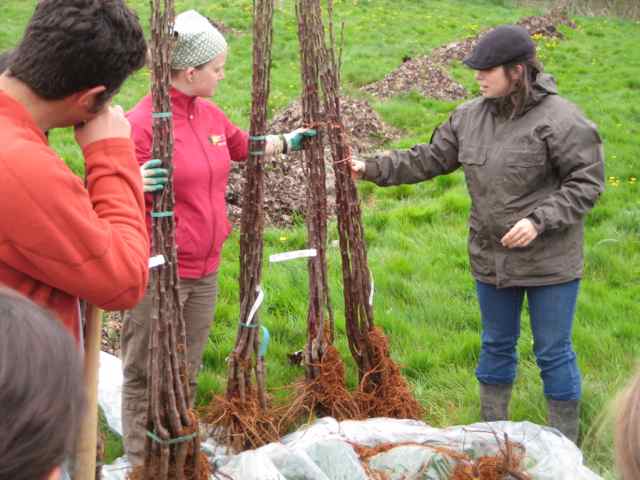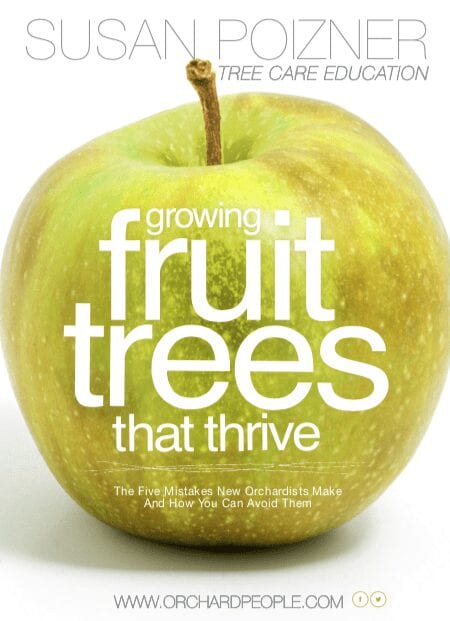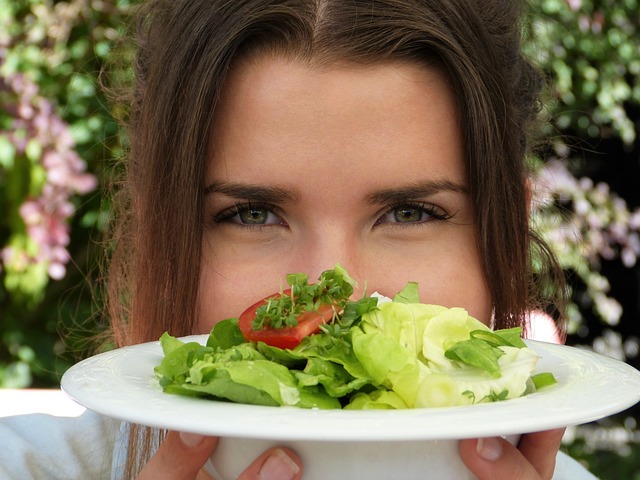
When to plant bare root fruit trees
Thinking about planting a fruit tree? If you want a tree that will be healthy and productive for years to come, you might want to consider choosing a bare root tree instead of a potted fruit tree from a big box store. You can order bare root fruit trees from specialist fruit tree nurseries. And they have lots of advantages. But they also have their own set of planting guidelines.
Of course, potted trees do have their perks. They’re convenient, because you can plant them any time during the growing season. In contrast, you can only plant bare root trees while they are dormant – usually in early spring or late fall. This timing is crucial for their success.
If you order your bare root fruit tree from a specialist fruit tree nursery it will arrive in the following spring or fall. These trees can’t survive long without soil around their roots, so you will want to plant them right away!
But wait! It’s important to consider the weather conditions! The pros and cons of planting on sunny versus overcast days can make a big difference. And in the midst of a windstorm? It’s probably wise to wait a day or two.
So, in this article we will explore:
- What bare root trees are
- Why it’s great to plant them
- When to plant your bare root trees so that they get the best start possible!
Let’s dig in!
What are bare root trees?

So, what exactly are bare root trees? These trees begin their journey at fruit tree nurseries where they are grafted and nurtured for a year or two before being ready for the public. Nurseries dig them out in early spring or late fall when these trees are dormant — without leaves, flowers, or fruit.
The nursery team then carefully wraps the roots in damp materials like hay, mulch, or newspaper, and seals them with plastic. This keeps the roots moist, ready for their journey in boxes to various destinations.
Here’s the catch: bare root trees can’t stay in this state for long. They need cool, dark conditions until planting time. If they get too much heat and sunlight, they’ll emerge from dormancy! The buds may break open and the tree will become stressed. Without soil, they’re at risk of dying.
That’s why it’s essential to plant these trees soon after you get them. If you notice their buds beginning to open, it’s a sign they’re emerging from dormancy, and it’s time to get those babies in the ground!

Fruit Tree Care Newsletter
Sign up for our monthly newsletter and we will send you our eBook “Growing Fruit Trees That Thrive.” You can unsubscribe at any time.
why plant bare root trees?
If bare root fruit trees are so fussy, why bother planting them at all? Well, there are lots of reasons. Here are just a few:
- Faster Growth: Bare root trees grow quicker and adapt more efficiently to new conditions compared to potted trees. This is because potted tree roots are often packed tightly into their pots. Root-bound trees will have trouble spreading out naturally in their new environment.
- Wider Variety: Specialist nurseries offer an extensive selection of bare root trees, including many varieties that are easier to grow and more resistant to disease. This diversity allows gardeners to choose the best trees for their specific climate and soil conditions.
- Younger Trees: Typically, bare root trees are younger than their potted counterparts. This makes them easier to prune and shape into a strong, fruit-bearing structure that can last a lifetime.
- Cost Effective: Bare root trees are generally more affordable. They’re cheaper to ship and don’t require costly pots and soil.
- Healthier Roots: These trees often have healthier, more naturally shaped root systems since their roots haven’t been restricted to a small pot. Healthy roots will result in a healthier tree.
- Easy Inspection: When your bare root tree arrives, you can inspect it very easily. If the roots are diseased, you will notice it and can ask for your money back!
- Eco-Friendly: Bare root fruit trees are more environmentally friendly since they don’t need plastic pots and other resources. trees means less use of plastic pots and potting soil.
Now, once you have your new bare root trees, you need to plant them ASAP. I’ll explore the pros and cons of the different planting day conditions below.

When to plant bare root fruit trees
A few years back, while being part of a number of bare root fruit tree planting projects, I found out first hand that the weather can impact planting day success! Here are some of my experiences:
Planting bare root fruit trees on a sunny day
My first planting was in Downsview Park’s beautiful orchard in North Toronto. Once a military base, this site now features almost 300 acres of parkland, including a spectacular orchard of over 150 trees. It was May and we added espalier apple trees, cherry shrubs, and currants to the orchard – and the day was fine, warm and sunny.
A sunny, fine day is great planting weather for us humans. There’s no need to wear raincoats and galoshes (does anyone wear galoshes anymore?). But for bare root trees, a sunny day can be challenging. That’s because if left in the sun, bare root trees may be triggered out of dormancy and their buds may start to open. To avoid stressing the trees, it is best to leave them in the shade while you dig your holes. You may also want to soak the roots in water for up to 30 minutes to help rehydrate them and prepare them for planting.

Planting bare root fruit trees in the rain
The second planting that year was at Gordonridge Place in Scarborough, Ontario. This public housing site has worked with FoodShare and their generous funders to create an extensive urban agriculture program, including a 30-tree orchard, vegetable plots, and even urban beekeeping. The soil is rich and the trees will love it. But the trees were shipped on a Friday. Planting day was Saturday. And the forecast was rain.
That didn’t stop the volunteers who showed up in their rain gear ready to work. We had a great, if slightly soggy, morning. But the best part is that the soil was soft and easy to dig. It was also moist and ready to accommodate the new bare root trees. After planting, the rain continued to “water in” the trees nicely, which would help them quickly settle in to their new site. There was no hot sun to trigger early opening of the buds. A rainy day is actually a terrific time to plant bare root trees.

Planting bare root fruit trees in wind and hail (!)
For the third planting that year, we had a bit of a surprise. We were scheduled to plant a number of bare root trees at the privately-owned San Romanoway apartment towers in the Jane and Finch neighbourhood in Toronto.
This site is at the heart of a fantastic greening project spearheaded by Toronto and Region Conservation‘s Black Creek Sustainable Neighbourhood Action Plan, in partnership with FoodShare. The project includes extensive urban agriculture developments and an orchard consisting of 24 trees. But on planting day in mid-May, there was an unseasonal windstorm and hail. The volunteers came ready to work, but this would have been a bad day for both the trees and the volunteers.
Planting a bare root tree in the whipping wind is not a good idea. With 37 km per hour wind (22 miles per hour), it would be hard work to just stand up straight – never mind digging holes! But this planting day would be even more challenging for the young trees. Newly planted trees have not yet established themselves, and could easily blow away in that kind of wind.
We decided to reschedule planting for the next day. We kept our fruit trees in a cool dark basement overnight to prevent them emerging from dormancy. And we were fortunate to have a warm, calm weather the following day.

Planting bare root trees, rain or shine
If you are planting bare root trees, the goal is to plant them as soon as you can. Rainy or overcast weather is perfect. A sunny day is fine too but you might want to plant the trees in the early morning before it gets too hot.
But, If there’s a windstorm or hail, you might want to keep your trees cool and plant the following day.
Once you plant your fruit trees properly, remember to water them regularly to help them establish themselves. Then you will need to prune and feed your trees annually and protect them from pests and diseases. You can learn all about that, and about fruit tree pruning, pest and disease prevention, soil management, and more in Orchard People’s online fruit tree care training.

Susan Poizner
Director, OrchardPeople.com Fruit Tree Care Education Online
#Bare #root #trees #plant




